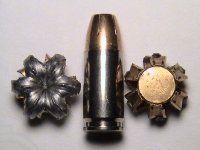Federal HST 230gr standard pressure is what you want. Heavier bullet will expand more and travel deeper in flesh (at least when comparing hst)
Buy it in 50ct boxes from SGammo or massammo, test it, and rest knowing you have one of the best if not arguably the best rounds on the market currently
I agree. Federal's HST ammo is the best hollow point round made. You would have a great round if you got any HST option for your gun OP, no matter the bullet size.
I did a test before using Federal HST, Speer GoldDot, Remington Golden Saber, and Precision Delta's hollow points in a home-brew.
I soaked about a dozen phone books in water, then stacked them up and shot into them. The HST expanded perfectly every single time, no matter the distance, without any debris clogging the cavity up. They also has excellent penetration.
The GoldDots let me down. The expansion was really hit or miss with them, and it wasn't dependent on distance. Some would get clogged with debris and not fully expand while others almost or fully expanded but still had debris caked in the center. The couple that did fully expand, were nothing like the razor sharp edges of the HST. Penetration wasn't bad with the GDs though.
The other ammo was much inferior than the top two. I still have the HST bullets I pulled out of those tests. They are so neat, I just had to keep them.
I understand the phone book test might not be the best replica of actual flesh, but if it can penetrate phonebooks without clogging and perfectly expanding every time, then I imagine it would be flawless for a SD situation.
Forgot to mention, this was the HST 124gr +P for 9mm, and so were the other brands. So I can just imagine the HST bullet in anything higher like a 45acp. I really wish they would make the HST in revolver rounds like 38spl and 357mag. Maybe even 44mag, even though THAT would be overkill, literally.
The only thing that might compare is the Winchester HPs, I forgot what they are called now, but I have never tried them. From what I have seen, they are quite similar to the HSTs, but after using the HSTs, I have no reason to try something else.


